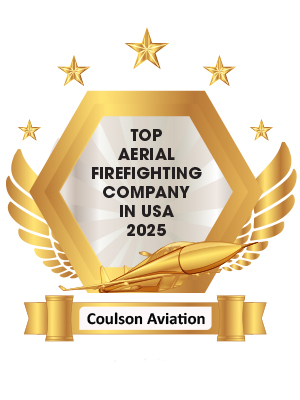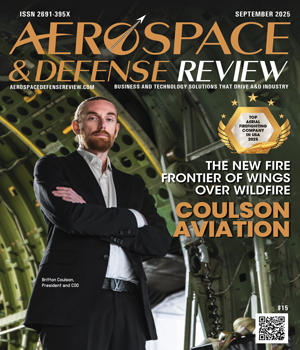THANK YOU FOR SUBSCRIBING
 Britton Coulson, President and COO, Wayne Coulson, President and CEO
Britton Coulson, President and COO, Wayne Coulson, President and CEOIn this high-stakes world of aerial firefighting, speed and precision can mean the difference between containment and catastrophe. The global industry leader that stands out with consistent clarity is Coulson Aviation.
Coulson Aviation is a unique embodiment of family-driven innovation, vertically integrated excellence, and an unwavering commitment to public safety and environmental stewardship.
By many accounts, Coulson Aviation is the largest aerial firefighting company in the world. But sheer size alone does not define its value or character.
What truly distinguishes the company is its singular capacity to provide end-to-end solutions across all aspects of aerial firefighting—from engineering and aircraft conversion to active deployment and mission coordination.
-
Firefighting is a very rewarding job. We’re not just putting out fires—we’re saving lives, we’re protecting homes, we’re defending forests, and we’re reducing pollution. We’re making a difference. And we’re just getting started
“We are among the last of our kind: a passionate, result-driven aerial firefighting enterprise that remains proudly family-owned,” says Britton Coulson, the company’s president and COO.
From Timber to Tankers
The story of Coulson Aviation begins long before it fought its first fire. The company’s roots trace back to 1960, when Coulson’s grandfather returned from World War II and purchased a bulldozer and logging truck to start a timber harvesting business.
 Based on the rugged and densely forested West Coast, the Coulsons thrived in the logging industry for decades. But by the 1980s, they saw an opportunity to innovate—and they took it.
Based on the rugged and densely forested West Coast, the Coulsons thrived in the logging industry for decades. But by the 1980s, they saw an opportunity to innovate—and they took it.
As traditional logging methods became less feasible in the Pacific Northwest, the company pioneered helicopter logging, adopting large aircraft like the Sikorsky S-61 to access previously unreachable, high-value timber. At the peak of operations, the Coulson Aviation fleet flew an astonishing 10,000 hours per year across four S-61 helicopters. Recognition came not just from the industry but also from original equipment manufacturers like Sikorsky and GE, who honored Coulson with multiple utilization awards.
Yet even then, the seeds of transformation were being planted. During the hot and dry summer months, helicopter logging was often suspended due to fire risk—a regulatory safeguard rooted in weather conditions. Rather than remain idle, the company began to pivot. It started deploying aircraft for aerial firefighting missions during those periods of enforced downtime. What began as a seasonal operation gradually evolved into a full-fledged business model.
Over time, Coulson Aviation recognized the enormous value—economic, environmental, and humanitarian—of aerial firefighting. The company chose to divest from its timber holdings entirely, returning its forest assets to local Indigenous communities. This transition marked a turning point.
Coulson Aviation became a focused, purpose-driven enterprise wholly dedicated to firefighting and emergency response.
Today, Coulson Aviation is the only aerial firefighting company in the world that is fully vertically integrated across every stage of operation. Its capabilities span air attack aircraft, large air tankers, lead planes, helicopter coordinators (helcos), and large helitankers. This comprehensive scope gives the company an unmatched ability to understand, control, and optimize every facet of a firefighting mission—from air traffic coordination to direct suppression. Coulson Aviation is pioneering night firefighting and is the only operator in the world conducting wildfire operations 24/7, 365 days a year.
 Even more remarkable are Coulson Aviation’s in-house engineering and aircraft conversion capabilities. Most companies either operate aircraft or build firefighting equipment—not both. Coulson designs, manufactures, installs, operates, and maintains all the systems it deploys. Whether it’s fitting a C-130 Hercules with a custom 4,000-gallon tank or developing proprietary modifications for a 737, every element is conceived and executed by Coulson Aviation’s integrated team. “There is a lot of pride and honor in what we do, and the responsibility we carry is to support those in times of need,” says Wayne Coulson.
Even more remarkable are Coulson Aviation’s in-house engineering and aircraft conversion capabilities. Most companies either operate aircraft or build firefighting equipment—not both. Coulson designs, manufactures, installs, operates, and maintains all the systems it deploys. Whether it’s fitting a C-130 Hercules with a custom 4,000-gallon tank or developing proprietary modifications for a 737, every element is conceived and executed by Coulson Aviation’s integrated team. “There is a lot of pride and honor in what we do, and the responsibility we carry is to support those in times of need,” says Wayne Coulson.
This level of vertical integration ensures technical consistency and operational adaptability. It allows the team to iterate quickly, implement feedback in real time, and enhance aircraft capabilities without the delays or compromises that often accompany third-party contractors. The result is a fleet that’s technologically superior, rigorously maintained, and constantly evolving.
The Era of the Megafire
If Coulson Aviation’s legacy is built on innovation, its future is defined by necessity. The world is entering what many experts now call the “era of the megafire”—a period marked by larger, more destructive, and more unpredictable wildfires. From the devastating blaze in Lahaina, Hawaii, to a series of winter-season fires in California, the new normal is anything but normal.
Coulson has a front-row seat to this transformation.
“We watched Lahaina happen, and everyone said it was a once-in-a-lifetime event,” Britton recalls. “Then we saw the Franklin Fire in Malibu—and that was in December. Then came January, and suddenly there were 70 fires over two weeks. We realized this wasn’t an anomaly—it’s a trend.”
In response, Coulson Aviation has been strategically investing in large air tankers and helitankers. These assets are critical during periods of extreme fire behavior, which are increasingly common due to climate change.
“Smaller aircraft have their place,” says Britton. “But when the fire index is high—when it’s hot, dry, and windy—you don’t see those aircraft flying. It’s the large tankers and helitankers that get the job done.”
Coulson Aviation’s aircraft—particularly its C-130s and converted 737s—offer payloads that far exceed the industry norm. While most large air tankers max out at 3,000 gallons, Coulson’s new-generation aircraft are pushing the envelope to 5,000 gallons. These aircraft aren’t just bigger—they’re more agile and capable of initial attack operations, allowing teams to intercept fires before they escalate into catastrophic events.
Global Reach, Local Impact
Coulson Aviation is not confined to North America. The company maintains full-time, year-round operations in both Chile and Australia, two countries that face seasonal wildfires regularly. These international missions are central to Coulson Aviation’s strategy and are proof of its logistical excellence and cultural adaptability.
 Back home in Southern California, the company’s Quick Reaction Force (QRF) has redefined how rapid aerial support is delivered. This specialized fleet includes Chinooks, S-61s, and S-76s, all pre-positioned for immediate deployment. Their presence has been a game-changer in recent fire seasons, providing the kind of immediate, large-scale response that can save not just property, but lives.
Back home in Southern California, the company’s Quick Reaction Force (QRF) has redefined how rapid aerial support is delivered. This specialized fleet includes Chinooks, S-61s, and S-76s, all pre-positioned for immediate deployment. Their presence has been a game-changer in recent fire seasons, providing the kind of immediate, large-scale response that can save not just property, but lives.
Take, for example, the Palisades Fire. Though the fire grew significantly, Coulson Aviation’s assets were strategically deployed to protect key evacuation routes and at-risk neighborhoods.
“There was one community with only one road in and out,” Coulson says. “We lost structures, but we didn’t lose a single life. That’s the kind of outcome that validates everything we do.”
Another example is the Sunset Fire, where Coulson Aviation’s intervention helped contain the blaze within hours— preventing what could have been $2 billion in property damage and the destruction of over 800 homes.
Fighting Fires, Saving Earth
Coulson Aviation’s impact goes far beyond the firelines. The environmental toll of wildfires is immense. Wildfires are among the top five global sources of pollution every year. They release megatons of carbon into the atmosphere, destroy biodiversity, and endanger watersheds. According to Coulson, preventing these fires from becoming mega events is “the lowest-hanging fruit” in the climate conversation.
“People talk a lot about electric vehicles and solar energy, which are important,” he says. “But nothing moves the environmental needle like preventing a wildfire from burning hundreds of thousands of acres.”
In that light, large aerial assets become more than just tools—they become strategic investments with tangible returns, not just for governments, but for the planet.
A Team with Purpose
Behind every aircraft in Coulson Aviation’s fleet is a team of dedicated professionals whose passion matches the company’s mission. From executive leadership to maintenance crews and flight teams, the company’s personnel are bound by a shared purpose: to protect life, property, and the environment.
 Most of the company’s vice presidents have been with the organization for 15 to 20 years. They are not merely employees—they are stewards of a legacy. The company also benefits from a steady influx of ex-military personnel, whose training in low-level, tactical operations translates seamlessly into the rigors of aerial firefighting.
Most of the company’s vice presidents have been with the organization for 15 to 20 years. They are not merely employees—they are stewards of a legacy. The company also benefits from a steady influx of ex-military personnel, whose training in low-level, tactical operations translates seamlessly into the rigors of aerial firefighting.
“These are people who have spent their careers serving their country,” Coulson explains. “At Coulson, they find a civilian mission that allows them to keep doing that—protecting people and communities in times of crisis.”
Personnel retention has never been a challenge—a rare claim in today’s labor market. However, with Coulson Aviation’s rapid expansion, recruitment and training remain top priorities to maintain operational readiness across continents and fire seasons.
A Singular Vision
In an industry where fragmentation is common, Coulson Aviation represents a model of coherence and capability. It is a company built on history, strengthened by innovation, and driven by mission. Its vision is not just about better aircraft—but better outcomes—for people, communities, and the planet.
From its humble origins in logging to its status today as a global leader in aerial firefighting, Coulson Aviation has never lost sight of what matters most: being there when the world needs them.
In Coulson’s words: “Firefighting is a very rewarding job. We’re not just putting out fires—we’re saving lives, we’re protecting homes, we’re defending forests, and we’re reducing pollution. We’re making a difference. And we’re just getting started.”
| Share this Article: |
Coulson Aviation
Company
Coulson Aviation
Management
Britton Coulson, President and COO, Wayne Coulson, President and CEO
Description
Coulson Aviation, a wholly owned subsidiary of the Coulson Group, is a dedicated aerial firefighting and emergency response company. It has full-time operations in Chile, Canada, Australia and Southern California. Its diverse rotary wing fleet consists of CH-47, S-61, UH-60, B412, and S76 , as well as robust fixed wing fleet of C-130 and 737 large air tankers along with Cessna Citation and Beechcraft King Air air attack and intelligence aircraft.






